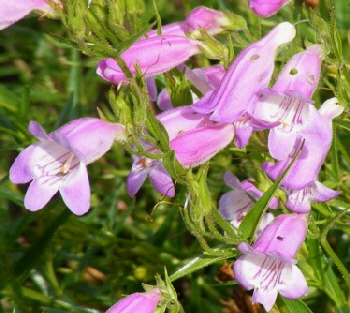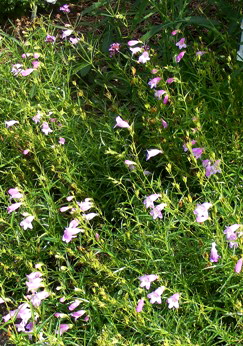Penstemon Beardtongue
Penstemon, commonly known as Beardtongue, is an easy to grow and care for perennial.
A western United States native prairie plant, Penstemon thrives in hot sunny conditions. There are approximately 275 species, some are tall and well suited to perennial gardens, some are small and better suited to rock gardens. All are loved by bees, butterflies and hummingbirds for the bright and colorful tubular blooms. Penstemon means five stamens, four are fertile and one is sterile. The sterile stamen has a tuft of small hairs, thus the common name beard tongue.
The taller varieties prefer ample space and are best appreciated when planted in a hedge-like row or well spaced masses. Certain varieties of beardtongue are short lived or bienniel, so be sure to get a hardy perennial variety. And there is a great variety of condition preferences, foliage types and leaf color, as well as flowers of many colors. Beardtongue flowers grow on long straight stems, so they are perfect for adding vertical height to a fresh floral arrangement. Sear the cut end of the stem with boiling water after freshly cut.
The low growing varieties are best viewed singly and up close and cannot be appreciated well if planted in masses, making no particular impact in that manner. The vast majority of low growing rock garden penstemon are wild native species, but recently some hybrids have been developed for garden use.
Penstemon barbatus ‘Prairie Dusk’
Common Name: Beardtongue
Plant Type: Herbaceous perennial
Height: 24-30”
Spread: 20-24”
Sun/Shade Requirements: Full Sun to part shade
Water Requirements: Average to dry
Soil Requirements: Average well drained soil. Tolerates clay soil, dry soil and drought.
Growth Habit: Upright clump
Bloom Time: June through July
Bloom Color: Lavender pink
Bloom Form: Tubular flared trumpet flowers
Foliage: Glossy dark green narrow leaves
Fragrance: None
Pest and Disease Resistance: Pest and disease resistant, leaf spot can occur on occasion. Root rot may occur if soil is too wet or poorly drained.
Fertilize: Top dress lightly with compost in spring.
Maintenance: Divide in spring every few years. Mulch in summer to retain moisture, mulch in winter in zone 3 and 4.
Other: Attracts birds, hummingbirds and butterflies. Deer resistant. Evergreen in the mildest regions.
Hardiness: Zones 3b, 4, 5, 6, 7, 8, 9
Beautiful rose purple flowers with white throats and magenta veining leading into the tubular bells are borne on tall stems held above the foliage. Deadheading spent flowers may prolong the bloom. The foliage of ‘Prairie Dusk’ tends to be shorter and more mounded than other penstemon, but the flower stems rise high above. The flowers tend to grow along a length of the flower stalk rather than in clusters or racemes like the digitalis species. Penstemon barbatus have strong stems and typically do not need any staking. And the Penstemon barbatus do not have the typical “beardtongue’, but rather a “beardlip” - a reflexed lower petal to accomodate hummingbirds. Foliage remains fresh through the season and is semi-evergreen in regions with warm winters. Excellent when planted in groups or masses in the perennial border, as an accent plant or in containers.
Penstemon digitalis ‘Czar’ / ‘Pensham Czar’
Common Name: Beardtongue
Plant Type: Herbaceous perennial
Height: 12-24”
Spread: 12-18”
Sun/Shade Requirements: Full Sun
Water Requirements: Average to dry
Soil Requirements: Average well drained soil. Tolerates clay soil, dry soil and drought.
Growth Habit: Upright clump
Bloom Time: May through July
Bloom Color: Plum purple with white throats
Bloom Form: Tubular flared trumpet flowers
Foliage: Shiny bright green narrow leaves
Fragrance: None
Pest and Disease Resistance: Pest and disease resistant, leaf spot can occur on occasion. Root rot may occur if soil is too wet or poorly drained.
Fertilize: Top dress lightly with compost in spring.
Maintenance: Divide in spring every few years. Mulch in summer to retain moisture, mulch in winter in zone 3 and 4.
Other: Attracts birds, hummingbirds and butterflies. Deer resistant. Evergreen in the mildest regions.
Hardiness: Zones 6, 7, 8, 9
The flowers of ‘Czar’ are quite large and flared open to show off white throats. ‘Czar’ has a fabulous plum color that really shows off the large open bells and contrast insides. Strong stems hold the large blooms upright over the foliage. Deadheading spent flowers may prolong the bloom period on this variety. In ideal conditions ‘Czar’ can bloom for as long as 5 months. The plant is stocky and dense and will hold up well through both wet and dry periods. A very easy to grow and care for perennial and is tall and elegant in perennial borders and containers. The foliage is semi-evergreen in warm regions. ‘Czar’ is one of the Pensham series bred by Edward Wilson. Most of his penstemon are crossed with “Just Jayne’ for strong stems and long flowering periods.
Penstemon digitalis ‘Dark Towers
Common Name: Beardtongue
Plant Type: Herbaceous perennial
Height: 36-36”
Spread: 12-24”
Sun/Shade Requirements: Full Sun to mostly sun
Water Requirements: Average to dry
Soil Requirements: Average well drained soil. Tolerates clay soil, dry soil and drought.
Growth Habit: Upright clump
Bloom Time: May through July
Bloom Color: Pale pink
Bloom Form: Tubular flared trumpet flowers
Foliage: Glossy maroon red narrow leaves
Fragrance: None
Pest and Disease Resistance: Pest and disease resistant, leaf spot can occur on occasion. Root rot may occur if soil is too wet or poorly drained.
Fertilize: Top dress lightly with compost in spring.
Maintenance: Divide in spring every few years. Mulch in summer to retain moisture, mulch in winter in zone 3 and 4.
Other: Attracts birds, hummingbirds and butterflies. Deer resistant. Evergreen in the mildest regions.
Hardiness: Zones 3, 4, 5, 6, 7, 8
‘Dark Towers’ pale pink flowers blend beautifully with its’ dark wine colored foliage. The flowers are borne atop strong stems. This penstemon will do well in heat and humidity. The foliage is somewhat similar to ‘Husker Red’, but ‘Dark Towers’ is darker and more red, and also seems to hold its dark red better through the summer. The plant is also taller than ‘Husker Red’ and of course pale pink blooms instead of white. It is considered by many to be an improved ‘Husker Red’ for its richer color and impact, but many of us are still partial to our “original” and quite satisfied with its performance. ‘Dark Towers’ will add dramatic rich color to perennial gardens or containers, and is excellent as an accent plant.
Penstemon digitalis ‘Husker Red’
Common Name: Beardtongue
Plant Type: Herbaceous perennial
Height: 2 - 3 feet
Spread: 1 to 2 feet
Sun/Shade Requirements: Full Sun to light shade
Water Requirements: Average to dry
Soil Requirements: Average well drained soil. Tolerates clay soil, dry soil and drought.
Growth Habit: Upright clump
Bloom Time: April to June
Bloom Color: White
Bloom Form: Tubular flared trumpet flowers
Foliage: Shiny deep green tinged maroon with maroon undersides.
Fragrance: None
Pest and Disease Resistance: Pest and disease resistant, leaf spot can occur on occasion. Root rot may occur if soil is too wet or poorly drained.
Fertilize: Top dress lightly with compost in spring.
Maintenance: Divide in spring every few years. Mulch in summer to retain moisture, mulch in winter in zone 3 and 4.
Other: Attracts birds, hummingbirds and butterflies. Deer resistant. Evergreen in the mildest regions.
Hardiness: Zones 3, 4, 5, 6, 7, 8
White tubular blooms with a pink blush are borne on dark maroon 3 foot erect stems from mid spring through early summer. ‘Husker Red’ can bloom profusely enough that support may be necessary. Colorful maroon red leaves are large at the base and become smaller and more lance shaped rising up the flower stem. The foliage remains fresh through the season, and spent blooms can be removed by snipping the flower stalks to a set of leaves. Self seeding may occur if blooms are left on the plant, but the seeds are often devoured by birds. This particular penstemon will do fairly well in hot and humid regions and in wet winters. Although ‘Husker Red’ is drought tolerant, it will prefer water every few days in extreme heat. Little or no fertilizer is required, a light dressing of compost in early spring is adequate. Give each plant plenty of space, plant 3 feet apart. The colorful foliage of ‘Husker Red’ makes a dramatic accent or specimen plant, and is also lovely in masses both in and out of bloom. Plant with bright foliage plants for a dramatic effect.
Penstemon digitalis x mexicali ‘Sweet Joanne’
Common Name: Beardtongue
Plant Type: Herbaceous perennial
Height: 12-18”
Spread: 12-18”
Sun/Shade Requirements: Full Sun
Water Requirements: Average to dry
Soil Requirements: Average well drained soil. Tolerates clay soil, dry soil and drought.
Growth Habit: Upright clump
Bloom Time: May through July
Bloom Color: Lavender pink
Bloom Form: Tubular flared trumpet flowers
Foliage: Shiny bright green narrow leaves
Fragrance: None
Pest and Disease Resistance: Pest and disease resistant, leaf spot can occur on occasion. Root rot may occur if soil is too wet or poorly drained.
Fertilize: Top dress lightly with compost in spring.
Maintenance: Divide in spring every few years. Mulch in summer to retain moisture, mulch in winter in zone 3 and 4.
Other: Attracts birds, hummingbirds and butterflies. Deer resistant. Evergreen in the mildest regions.
Hardiness: Zones 5, 6, 7, 8, 9
‘Sweet Joanne’ is probably the best all around Penstemon with a long bloom season, big flowers in abundance and lovely fresh foliage. Bright pink bells with white throats and magenta veining are striking in the summer garden. ‘Sweet Joanne’ has a long bloom period and produces a profusion of cheerful 1 1/4” blooms that attract hummingbirds and bees. It is thought that the bright veining in the flower throat guides the hummingbirds and bees to the nectar deep in the trumpet. ‘Sweet Joanne’ will do best in at least 6 to 8 hours of sun, and will hold up quite well in heat, humidity and drought. Clump size will increase each year as the plant becomes established. If you prefer a more dense and compact plant, cut back the entire plant to about half or even two thirds after flowering. The flower stalks may be cut back to a set of leaves after flowering has finished, fall blooming may be encouraged in this variety. ‘Sweet Joanne’ has a dense and compact form of bright foliage that is always lovely in a cottage garden and sunny perennial borders. The entire plant is very pretty and somewhat delicate looking, but is hardy enough to survive zone 5 winters, and zone 4 with winter protection.
There are many, many penstemon varieties that are native to the warmer regions of the south and southwest. There are also many short lived penstemons grown from seed, and available through seed companies and wildflower companies. We are also starting to see new hybrids and cultivars that are hardy perennials in the midwest, so watch your garden center for new introductions.







